|
Glamour International Magazines & Albums
(1982-2001 - Glamour International) 
We canvas here a number of periodical volumes of this very well-regarded Italian publisher. You can see that they started with run that has become categorized as the "First Series", all volumes falling -BELOW THE LINE- as we score them, but the "Second Series", with the occasionally interspersed heftier "Albums", achieving the attention they deserve. In looking at those later editions, we still find some that don't have enough art overall to get up onto our 'artbook list'. (If you care about our ranking of those Second Series publications making it up onto The List, number 19 is the best presentation, followed then by 17, 11(supplement), 11, 26, 14, & 15).
We start with that First Series, all saddle-stitched (robbing them of having a real spine), placing them all BELOW THE LINE as far as this website is concerned. They are also roughly 13-inches-by-13-inches, larger than a vinyl LP record album, making them a bit more unweildy than can be recommended. Almost all text in them appears in English & French, as well as the native Italian. The merchant links are to their Amazon.com entries, but their availability there is sporadic at best. They are presented in the order they were published.
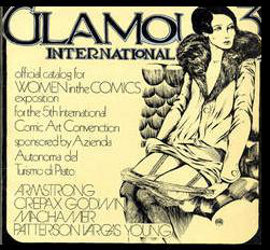 # 3 (1982) [-BELOW THE LINE-] - This volume is built around the theme of Women In Comics, but the inclusion of Rolf Armstrong and Alberto Vargas works dilutes that a bit. A number of pages present drawing examples from single-panel gag-cartoons, but more are given over to the sequential art of comic strips with their female characters. A couple of short essays are given in both Italian and English. Focusing so much on works from the first half of the last century keeps the sexuality pretty mild, but some of the European sequential art does start down the road to salaciousness. 68 pages, counting the covers. There are 19 pages dedicated to a single large reproduction each, leaving another 10 with multiple examples. The 'well-presented' artists are: Rolf Armstrong (2), Guido Crepax, Jefferson Machamer, George McManus (2), Russell Patterson and Alberto Vargas (12). # 3 (1982) [-BELOW THE LINE-] - This volume is built around the theme of Women In Comics, but the inclusion of Rolf Armstrong and Alberto Vargas works dilutes that a bit. A number of pages present drawing examples from single-panel gag-cartoons, but more are given over to the sequential art of comic strips with their female characters. A couple of short essays are given in both Italian and English. Focusing so much on works from the first half of the last century keeps the sexuality pretty mild, but some of the European sequential art does start down the road to salaciousness. 68 pages, counting the covers. There are 19 pages dedicated to a single large reproduction each, leaving another 10 with multiple examples. The 'well-presented' artists are: Rolf Armstrong (2), Guido Crepax, Jefferson Machamer, George McManus (2), Russell Patterson and Alberto Vargas (12).
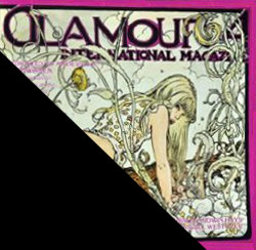 # 4 (1982) [-BELOW THE LINE-] (full cover withheld) - Not appropriate for minors. Only 40 pages (counting the covers and inner leaves) with 21 being dominated by non-sequential art, 16 of those being very large reproductions (including the color Manara double-page spread used as a wrap-around cover). This issue is self-indicated as "Dedicated to made in U.S. hero women" and continues the presentation of a number of early American newspaper strips with strong female leads. Some of the artists produce homages to such iconic characters as Diana Palmer, Princess Narda, Miss Lace, Daisy Mae, Dale Arden and Princess Aura. Enough nudity combined with adult salaciousness to need to be put away from children. The 'well-presented' artists are: Alarico Gattia (2), Charles Dana Gibson (2), René Giffey (2), John LaGatta, Milo Manara (4), J.H. Striebel, Sergio Toppi (3) & UNKNOWN. # 4 (1982) [-BELOW THE LINE-] (full cover withheld) - Not appropriate for minors. Only 40 pages (counting the covers and inner leaves) with 21 being dominated by non-sequential art, 16 of those being very large reproductions (including the color Manara double-page spread used as a wrap-around cover). This issue is self-indicated as "Dedicated to made in U.S. hero women" and continues the presentation of a number of early American newspaper strips with strong female leads. Some of the artists produce homages to such iconic characters as Diana Palmer, Princess Narda, Miss Lace, Daisy Mae, Dale Arden and Princess Aura. Enough nudity combined with adult salaciousness to need to be put away from children. The 'well-presented' artists are: Alarico Gattia (2), Charles Dana Gibson (2), René Giffey (2), John LaGatta, Milo Manara (4), J.H. Striebel, Sergio Toppi (3) & UNKNOWN.
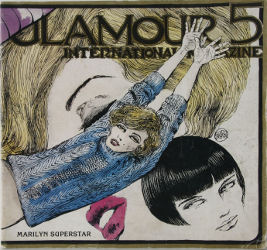 # 5 (1982) [-BELOW THE LINE-] - 48 pages, counting the covers and the inner liners. The headlined theme is "Marilyn Superstar" (a visual homage to Marilyn Monroe), but the usual page count is taken up by reprinting the American adventure newspaper strip CONNIE, as well as the current installments of two ongoing modern graphic stories. So, there are 18 pages, each with a single 'well-presented' piece and another four with multiple images. The 'well-presented' artists are: Carl Barks (2), Howard Chaykin, Guido Crepax (5), Vittorio Giardino, Robert Gigi, Annie Goetzinger, John Held Jr., Fabius Lorenzi, Russell Patterson (2) and Hugo Pratt. There is a bit of nudity throughout. # 5 (1982) [-BELOW THE LINE-] - 48 pages, counting the covers and the inner liners. The headlined theme is "Marilyn Superstar" (a visual homage to Marilyn Monroe), but the usual page count is taken up by reprinting the American adventure newspaper strip CONNIE, as well as the current installments of two ongoing modern graphic stories. So, there are 18 pages, each with a single 'well-presented' piece and another four with multiple images. The 'well-presented' artists are: Carl Barks (2), Howard Chaykin, Guido Crepax (5), Vittorio Giardino, Robert Gigi, Annie Goetzinger, John Held Jr., Fabius Lorenzi, Russell Patterson (2) and Hugo Pratt. There is a bit of nudity throughout.
 # 7 (1982) [-BELOW THE LINE-] - 40 pages and the only 'well-presented' art is a Guido Crepax portrait of Dixie Dugan and Vittorio Giardino's wrap-around cover. For the most part, this issue is a overview of early British female newspaper strips, so presentations of sequential-art dominate almost all the pages. There are a few grey-tone reproductions of color George Petty pieces that can be found better presented elsewhere. What nudity there is is pretty tame. # 7 (1982) [-BELOW THE LINE-] - 40 pages and the only 'well-presented' art is a Guido Crepax portrait of Dixie Dugan and Vittorio Giardino's wrap-around cover. For the most part, this issue is a overview of early British female newspaper strips, so presentations of sequential-art dominate almost all the pages. There are a few grey-tone reproductions of color George Petty pieces that can be found better presented elsewhere. What nudity there is is pretty tame.
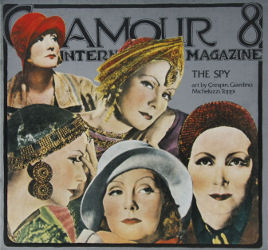 # 8 (1983) [-BELOW THE LINE-] - 40 pages, counting the covers and the inner liners. The headlined theme is "The Spy", but again, reprinting of American adventure newspaper strips with strong female leads takes up two-thirds of the publication. Among all that are 10 pages with a single 'well-presented' piece and another three each with several examples of Milton Caniff single-panel gag-strip THE GAY THIRTIES. The 'well-presented' artists are: Michel Crespin, Arthur Ferrier (2), Vittorio Giardino, Albert Guillaume (4), Attilio Micheluzzi and Sergio Toppi. The cover and center section are photographs of femme fatales that have played spies in the cinema and some of the 'well-presented' images are a few of the artists' spy-related works. No nudity in this issue to speak of. # 8 (1983) [-BELOW THE LINE-] - 40 pages, counting the covers and the inner liners. The headlined theme is "The Spy", but again, reprinting of American adventure newspaper strips with strong female leads takes up two-thirds of the publication. Among all that are 10 pages with a single 'well-presented' piece and another three each with several examples of Milton Caniff single-panel gag-strip THE GAY THIRTIES. The 'well-presented' artists are: Michel Crespin, Arthur Ferrier (2), Vittorio Giardino, Albert Guillaume (4), Attilio Micheluzzi and Sergio Toppi. The cover and center section are photographs of femme fatales that have played spies in the cinema and some of the 'well-presented' images are a few of the artists' spy-related works. No nudity in this issue to speak of.
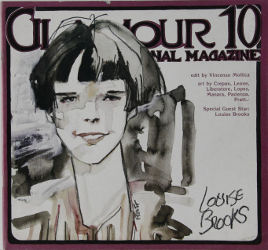 # 10 (1983) [-BELOW THE LINE-] - Not appropriate for children or adolescents. 40 pages, counting inner & outer covers. The back cover is a typography-free version of the front. This time, the actress Louise Brooks is billed as the book's "guest star", which seems proper nomenclature since, again, most of the book is used to reprint American adventure strips (Connie, Boots And Her Buddies, and Flyin' Jennie) along with some other sequential art. So, the book has only a single multi-image page and then seven 'well-presented' drawing-portraits of Louise Brooks by: Guido Crepax, Tanino Liberatore (2), Milo Manara, Andrea Pazienza (2) and Hugo Pratt. One image is extreme fetishistic enough to make the book not appropriate for minors. # 10 (1983) [-BELOW THE LINE-] - Not appropriate for children or adolescents. 40 pages, counting inner & outer covers. The back cover is a typography-free version of the front. This time, the actress Louise Brooks is billed as the book's "guest star", which seems proper nomenclature since, again, most of the book is used to reprint American adventure strips (Connie, Boots And Her Buddies, and Flyin' Jennie) along with some other sequential art. So, the book has only a single multi-image page and then seven 'well-presented' drawing-portraits of Louise Brooks by: Guido Crepax, Tanino Liberatore (2), Milo Manara, Andrea Pazienza (2) and Hugo Pratt. One image is extreme fetishistic enough to make the book not appropriate for minors.
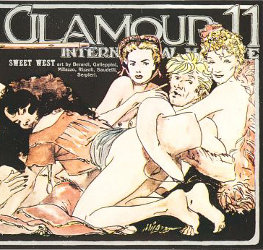 # 11 (1983) [-BELOW THE LINE-] - Not appropriate for children or adolescents. 40 pages, counting inner covers and wraparound cover. The headlined theme is "Sweet West", but again, reprinting of American adventure newspaper strips with strong female leads takes up two-thirds of the publication. Among all that are ten pages with a single 'well-presented' piece and another with two large reproductions. The 'well-presented' artists are: Carl Barks (2), Aurelio Galleppini, Charles Dana Gibson, Ivo Milazzo (4), B.M. Rizzoli and Paolo Serpieri. "Sweet West" is six western-themed pieces and a short graphic story which itself explores the seedier adult side of the old west enough to make the book not appropriate for minors. # 11 (1983) [-BELOW THE LINE-] - Not appropriate for children or adolescents. 40 pages, counting inner covers and wraparound cover. The headlined theme is "Sweet West", but again, reprinting of American adventure newspaper strips with strong female leads takes up two-thirds of the publication. Among all that are ten pages with a single 'well-presented' piece and another with two large reproductions. The 'well-presented' artists are: Carl Barks (2), Aurelio Galleppini, Charles Dana Gibson, Ivo Milazzo (4), B.M. Rizzoli and Paolo Serpieri. "Sweet West" is six western-themed pieces and a short graphic story which itself explores the seedier adult side of the old west enough to make the book not appropriate for minors.
==================================================================================
I'm not sure what spurred the end of this last series and then the releasing of more as a Second Series, but after a couple of such issues, they were re-formulated - more material, thicker editions, with flat spines (though usually unmarked...) And the height & width were reduced slightly, but enough to drop back into our window of managability. Almost all text in them still appears in English & French, as well as the native Italian. Once again, the merchant links are to their Amazon.com entries, but their availability there is sporadic at best. Again, the ones we have here are in release order, with the special 'albums' interspaced as they appeared.
 # 2 (1985) [-BELOW THE LINE-] Not appropriate for children or adolescents. Issue # 2 was still in the older format, so it's difficult to just sit back and flip thru it. The 80-page book is stapled, robbing it of a real spine. The theme here is of brothels. There are articles about brothels in the world of movies, comics and real life. There are any number of photographs of brothel denizens and the art is frequently of adult themes, so the book should be kept put away from children. There are off-message distractions like a few pages of reprinted comic strips from Norman Pett's JANE series and a gallery of some of Frank Frazetta's men's magazines illustrations. 40 pages are dominated by the art, with 22 of those being each a large display of a piece. The artists getting full-page reproductions of their work are: Jordi Bernet, Guido Buzzelli, Guido Crepax, Frank Frazetta (5)*, Leone Frollo, Vittorio Giardino, José "Pepe" Gonzales, G. Leclaire (2), Tanino Liberatore, Milo Manara, Sesar (2), Jacques Tardi, Daniel Torres and Alex Varenne. # 2 (1985) [-BELOW THE LINE-] Not appropriate for children or adolescents. Issue # 2 was still in the older format, so it's difficult to just sit back and flip thru it. The 80-page book is stapled, robbing it of a real spine. The theme here is of brothels. There are articles about brothels in the world of movies, comics and real life. There are any number of photographs of brothel denizens and the art is frequently of adult themes, so the book should be kept put away from children. There are off-message distractions like a few pages of reprinted comic strips from Norman Pett's JANE series and a gallery of some of Frank Frazetta's men's magazines illustrations. 40 pages are dominated by the art, with 22 of those being each a large display of a piece. The artists getting full-page reproductions of their work are: Jordi Bernet, Guido Buzzelli, Guido Crepax, Frank Frazetta (5)*, Leone Frollo, Vittorio Giardino, José "Pepe" Gonzales, G. Leclaire (2), Tanino Liberatore, Milo Manara, Sesar (2), Jacques Tardi, Daniel Torres and Alex Varenne.
* - Note that Frazetta's 'well-presented' pieces here can also be found so in his own collections up on The List.
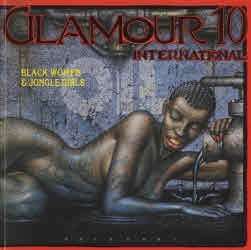 # 10 (1987) [-BELOW THE LINE-] Not appropriate for children or adolescents. Issue # 10 (88 pages) is subtitled 'Black Women & Jungle Girls', but it strays from there with a photographic chapter devoted to B-Movie Scream-Queens, a nine-page Bill Ward Torchy Todd story reprint and a section devoted to the Federico Fellini film, INTERVISTA. The pages tied to the issue's theme are also filled with photos and some sequential art - so the book, as a whole, is lacking enough art to keep it up on The List. There's a striking Jim Steranko tall jungle-girl piece, but it is unfortunately turned sideways. The are seven other double-page-spreads, but almost all of them seem to remain effective. A couple of the art pieces stray into adults-only status. The artists seen 'well-presented' are: Armando Calvelli, Silvio Caudelo, Oscar Chichoni (2), Beb Deum, Frank Frazetta (2)*, Leone Frollo, Tonino Liberatore, Antonio Lopez (2), Magnus, Milo Manara, José Antonio Muñoz, Andrea Pazienza, Franco Saudelli, Filippo Scozzari, Dave Stevens (2)***, and Bill Ward. # 10 (1987) [-BELOW THE LINE-] Not appropriate for children or adolescents. Issue # 10 (88 pages) is subtitled 'Black Women & Jungle Girls', but it strays from there with a photographic chapter devoted to B-Movie Scream-Queens, a nine-page Bill Ward Torchy Todd story reprint and a section devoted to the Federico Fellini film, INTERVISTA. The pages tied to the issue's theme are also filled with photos and some sequential art - so the book, as a whole, is lacking enough art to keep it up on The List. There's a striking Jim Steranko tall jungle-girl piece, but it is unfortunately turned sideways. The are seven other double-page-spreads, but almost all of them seem to remain effective. A couple of the art pieces stray into adults-only status. The artists seen 'well-presented' are: Armando Calvelli, Silvio Caudelo, Oscar Chichoni (2), Beb Deum, Frank Frazetta (2)*, Leone Frollo, Tonino Liberatore, Antonio Lopez (2), Magnus, Milo Manara, José Antonio Muñoz, Andrea Pazienza, Franco Saudelli, Filippo Scozzari, Dave Stevens (2)***, and Bill Ward.
* - Note that Frazetta's 'well-presented' pieces here can also be found so in his own collections higher up The List.
*** - Note that Steven's 'well-presented' pieces here also appear so in his own collection higher up The List (but the Sheena piece is not in color there)
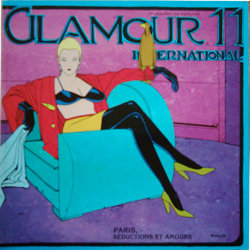 # 11 (1987) - Not appropriate for children or adolescents. PARIS, SEDUCTIONS ET AMOURS [PARIS, SEDUCTIONS AND LOVES] is registered as the sub-title and indeed the theme is the exploration of the legend of the steamier, seedier side of Paris nightlife (I choose 'legend of', because the reality, past or present, is not really the pursuit - it's the glamour of it all that is being sought out . . .). Presented are essays, memoirs, photos, sketchs, drawings, paintings and comics - all to flesh out the perception of the naughty things at play out of the mainstream's sight. This book is 88 pages when you include the inner liners and Moebius's wraparound cover. That cover is one of six double-page presentations, all of which incorporate the book's center acceptably. Otherwise, there are 33 pages with each a large dominant art piece and another 17 with multiple images. Nudity abounds and as you would imagine, many depictions here embrace adult themes as well, so the book should be kept put away from minors. 'Well-presented' artists are: Horacio Altuna, Gerard Bouysse, Silvio Cadelo, J. David, H.C. DeLugo, André Digimont, Epulone Forest, Vittorio Giardino, Jean Giraud (Moebius), Henri de Toulouse-Latrec (2), Tanino Liberatore, Lindsay (4), Regis Loisel, Jefferson Machamer, Milo Manara (3), Riccardo Mannelli, George Pichard, Félicien Rops, Sergio Toppi (2), and UNKNOWN. Note that registered as the 'supplement' to this issue is the Glamour International Album, Bizarre Life 1. # 11 (1987) - Not appropriate for children or adolescents. PARIS, SEDUCTIONS ET AMOURS [PARIS, SEDUCTIONS AND LOVES] is registered as the sub-title and indeed the theme is the exploration of the legend of the steamier, seedier side of Paris nightlife (I choose 'legend of', because the reality, past or present, is not really the pursuit - it's the glamour of it all that is being sought out . . .). Presented are essays, memoirs, photos, sketchs, drawings, paintings and comics - all to flesh out the perception of the naughty things at play out of the mainstream's sight. This book is 88 pages when you include the inner liners and Moebius's wraparound cover. That cover is one of six double-page presentations, all of which incorporate the book's center acceptably. Otherwise, there are 33 pages with each a large dominant art piece and another 17 with multiple images. Nudity abounds and as you would imagine, many depictions here embrace adult themes as well, so the book should be kept put away from minors. 'Well-presented' artists are: Horacio Altuna, Gerard Bouysse, Silvio Cadelo, J. David, H.C. DeLugo, André Digimont, Epulone Forest, Vittorio Giardino, Jean Giraud (Moebius), Henri de Toulouse-Latrec (2), Tanino Liberatore, Lindsay (4), Regis Loisel, Jefferson Machamer, Milo Manara (3), Riccardo Mannelli, George Pichard, Félicien Rops, Sergio Toppi (2), and UNKNOWN. Note that registered as the 'supplement' to this issue is the Glamour International Album, Bizarre Life 1.
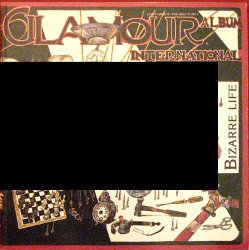 Bizarre Life 1 (Supplement to #11) (cover withheld) Not appropriate for children & adolescents. This book, a large (12x12) square volume, has 84 pages with art on the inner liners and the 'wraparound' cover, the focus here being what is now considered the American classic fetish-lingerie-bondage milieu of the 1940s & 50s, accompanied by a section on the more modern Guido Crepax. There are 52 art pages, with 42 of those having each a single large dominant reproduction. The other 36 pages are comprised mostly of sequential-art and the racy black-and-white pictures (many of them of Betty Page) that you could get in that earlier period, either under-the-counter or through the mail. The text & essays are presented in English and French, in addition to the native Italian. The captioning of the pieces seems adequate. With all the depictions of S-&-M fetishism, this is clearly not meant for minors. The 'well-presented' artists here are: Gene Bilbrew (Eneg) (5), Milton Caniff, Guido Crepax (16), Jean Giraud (Moebius), Allen Jones, Eric Stanton (7), Bill Ward (5) and John Willie (3). Bizarre Life 1 (Supplement to #11) (cover withheld) Not appropriate for children & adolescents. This book, a large (12x12) square volume, has 84 pages with art on the inner liners and the 'wraparound' cover, the focus here being what is now considered the American classic fetish-lingerie-bondage milieu of the 1940s & 50s, accompanied by a section on the more modern Guido Crepax. There are 52 art pages, with 42 of those having each a single large dominant reproduction. The other 36 pages are comprised mostly of sequential-art and the racy black-and-white pictures (many of them of Betty Page) that you could get in that earlier period, either under-the-counter or through the mail. The text & essays are presented in English and French, in addition to the native Italian. The captioning of the pieces seems adequate. With all the depictions of S-&-M fetishism, this is clearly not meant for minors. The 'well-presented' artists here are: Gene Bilbrew (Eneg) (5), Milton Caniff, Guido Crepax (16), Jean Giraud (Moebius), Allen Jones, Eric Stanton (7), Bill Ward (5) and John Willie (3).
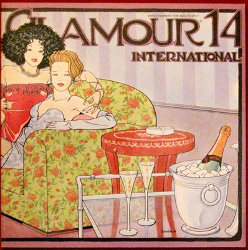 # 14 (1989) Not appropriate for children or adolescents. An 96-page issue, with a wraparound cover, with a stated theme of lesbianism. Most of the book does focus on that, but then the last third shifts to featuring a Guido Crepax comic story, Milo Manara & Massimo Frezatto art and some European traditional erotic art from the past. There are materials in both the on-message and off-message sections that depict adult themes and dictate that this book should not be accessable by minors. There is a lot of text and title pages, as well as photographs throughout, but pages dominated by the art hold a slim majority, with 22 of them sporting multiple images and another 29 featuring large reproductions. Most things are captioned, identifying the source and artist, if known. The 'well-presented' artists found here are: Allessando Baldanzi (2), Gianni Brunoro, Howard Chaykin, Guido Crepax (2), Massimo Frezatto (3), Leone Frollo (8)**, Vittorio Giardino, Gustav Klimt, Laura, Tanino Liberatore, Milo Manara (3), Georges Pichard, Bill Ward & UNKNOWN (3). # 14 (1989) Not appropriate for children or adolescents. An 96-page issue, with a wraparound cover, with a stated theme of lesbianism. Most of the book does focus on that, but then the last third shifts to featuring a Guido Crepax comic story, Milo Manara & Massimo Frezatto art and some European traditional erotic art from the past. There are materials in both the on-message and off-message sections that depict adult themes and dictate that this book should not be accessable by minors. There is a lot of text and title pages, as well as photographs throughout, but pages dominated by the art hold a slim majority, with 22 of them sporting multiple images and another 29 featuring large reproductions. Most things are captioned, identifying the source and artist, if known. The 'well-presented' artists found here are: Allessando Baldanzi (2), Gianni Brunoro, Howard Chaykin, Guido Crepax (2), Massimo Frezatto (3), Leone Frollo (8)**, Vittorio Giardino, Gustav Klimt, Laura, Tanino Liberatore, Milo Manara (3), Georges Pichard, Bill Ward & UNKNOWN (3).
** - Note that none of Frollo's 'well-presented' pieces counted here appear so in his own collections on The List.
 # 15 (1991) Not appropriate for children or adolescents. The implicit theme here is 'The Female Mouth'. There is a large section of celebrity photo-portraits, seemingly to spotlight that much of their fame may have lain in how attractive their lips were or how they 'posed' them to contribute to their unique countenances. There are also 32 pages with large single art reproductions and another 14 multiple-image pages to continue the same general discussion in the non-photographic arena (the book has 96 pages overall). While not in the majority, there is a significant focus on fellatio that moves this book into the 'Adults Only' area. The 'well-presented' artists are: Allessando Baldanzi, Enoch Bolles, Peter Driben, Leo Fontan, Leone Frollo, Jean Giraud (Moebius), Regis Loisel, Milo Manara, Riccardo Mannelli (6), Giuseppe Palumbo, George Pichard and UNKNOWN (9). # 15 (1991) Not appropriate for children or adolescents. The implicit theme here is 'The Female Mouth'. There is a large section of celebrity photo-portraits, seemingly to spotlight that much of their fame may have lain in how attractive their lips were or how they 'posed' them to contribute to their unique countenances. There are also 32 pages with large single art reproductions and another 14 multiple-image pages to continue the same general discussion in the non-photographic arena (the book has 96 pages overall). While not in the majority, there is a significant focus on fellatio that moves this book into the 'Adults Only' area. The 'well-presented' artists are: Allessando Baldanzi, Enoch Bolles, Peter Driben, Leo Fontan, Leone Frollo, Jean Giraud (Moebius), Regis Loisel, Milo Manara, Riccardo Mannelli (6), Giuseppe Palumbo, George Pichard and UNKNOWN (9).
 Sweet Bettie 1 (Supplement to #16) (full cover withheld) [-BELOW THE LINE-] Not appropriate for children & adolescents. SWEET BETTIE 1 is a 100-page book that unfortunately utilizes way too many of its pages to reprint appearances of Bettie Page in Robert Harrison's gag cheesecake magazines, leaving only 21 art pages (but nearly every one of those features a large reproduction). The title is a riff on John Willie's constantly bound heroine, Sweet Gwendoline, with a number of Leone Frollo pieces with Bettie in the same predicaments. The rest of the art is more Bettie by a handful of artists. In all, the 'well-presented' artists are: Harmand Balds (9), Olivia DeBerardinis (2), Leone Frollo (6) and Peter Nicone (3). The few examples of saliciousness and fetishism push this into an adults-only category. Sweet Bettie 1 (Supplement to #16) (full cover withheld) [-BELOW THE LINE-] Not appropriate for children & adolescents. SWEET BETTIE 1 is a 100-page book that unfortunately utilizes way too many of its pages to reprint appearances of Bettie Page in Robert Harrison's gag cheesecake magazines, leaving only 21 art pages (but nearly every one of those features a large reproduction). The title is a riff on John Willie's constantly bound heroine, Sweet Gwendoline, with a number of Leone Frollo pieces with Bettie in the same predicaments. The rest of the art is more Bettie by a handful of artists. In all, the 'well-presented' artists are: Harmand Balds (9), Olivia DeBerardinis (2), Leone Frollo (6) and Peter Nicone (3). The few examples of saliciousness and fetishism push this into an adults-only category.
 # 17 (1991) - This issue self-identifies as exploring "American Good Girl Art 1900 - 1950s" with info and examples from Alberto Becattini. At the time, 1991, Becattini and the editors felt the working definition of Good Girl art was that found from the early-1940s through the mid-1950s inception of the Comics Code in the comic-books that focused on near pin-up renditions of their female characters (regardless of their morality . . .) and, for their purposes, they were going to broaden that to additionally include work found in comic-strips, magazines & on paperback covers, as well as expand the time-frame to begin at the earlier turn-of-the-century and on-goingly continue through present-day. As you've gathered, that looser definition seems actually to be the norm now. (To be helpful, let's add that, as of this writing, Wikipedia is alternatively defining Bad Girl Art to be that of the revealingly-costumed, morally ambiguous, supernatural super-heroines, found specifically in comic-books starting in the early-1990s). With that said, this issue then scores as one of the best art presentations of this series. You have 108 pages that contains Becattini's essay (in Italian, English & French) and page after page of cataloguing the artists that produced this kind of work in the 1900-1950s time-period (being the first of two planned volumes). There seems to be at least one example from each artist. That creates 82 pages where the art dominates - 17 of those feature nearly-full-page reproductions, along with the front & back covers of the book. Unfortunately, some of the other pages have out-of-focus images and black-&-white pictures of color works. There is some female nudity, but all of this was work found in the mainstream during those years. The 'well-presented' artists are: Carl Barks, Margaret Brundage*, Al Buell, Howard Chandler Christy, Peter Driben, Will Eisner, James Montgomery Flagg, Edwin Georgi, Arnold Kohn, J.C. Leyendecker (2), Earl MacPherson, Al Moore, George Petty (2)**, Norman Saunders (as Blaine), Raeburn VanBuren, Coby Whitmore and Fritz Willis. # 17 (1991) - This issue self-identifies as exploring "American Good Girl Art 1900 - 1950s" with info and examples from Alberto Becattini. At the time, 1991, Becattini and the editors felt the working definition of Good Girl art was that found from the early-1940s through the mid-1950s inception of the Comics Code in the comic-books that focused on near pin-up renditions of their female characters (regardless of their morality . . .) and, for their purposes, they were going to broaden that to additionally include work found in comic-strips, magazines & on paperback covers, as well as expand the time-frame to begin at the earlier turn-of-the-century and on-goingly continue through present-day. As you've gathered, that looser definition seems actually to be the norm now. (To be helpful, let's add that, as of this writing, Wikipedia is alternatively defining Bad Girl Art to be that of the revealingly-costumed, morally ambiguous, supernatural super-heroines, found specifically in comic-books starting in the early-1990s). With that said, this issue then scores as one of the best art presentations of this series. You have 108 pages that contains Becattini's essay (in Italian, English & French) and page after page of cataloguing the artists that produced this kind of work in the 1900-1950s time-period (being the first of two planned volumes). There seems to be at least one example from each artist. That creates 82 pages where the art dominates - 17 of those feature nearly-full-page reproductions, along with the front & back covers of the book. Unfortunately, some of the other pages have out-of-focus images and black-&-white pictures of color works. There is some female nudity, but all of this was work found in the mainstream during those years. The 'well-presented' artists are: Carl Barks, Margaret Brundage*, Al Buell, Howard Chandler Christy, Peter Driben, Will Eisner, James Montgomery Flagg, Edwin Georgi, Arnold Kohn, J.C. Leyendecker (2), Earl MacPherson, Al Moore, George Petty (2)**, Norman Saunders (as Blaine), Raeburn VanBuren, Coby Whitmore and Fritz Willis.
* - Note that Brundage's 'well-presented' piece here can additionally be found so in her own collection further up on The List.
* - Note that Petty's 'well-presented' pieces here cannot additionally be found so in his own collection further on The List.
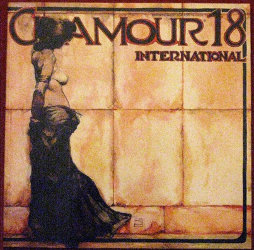 # 18 (1992) [-BELOW THE LINE-] Not appropriate for children or adolescents. This issue is on witches - well, the sexy ones, anyway. Out of the book's 100 pages, only 41 let art dominate, with 21 of those featuring a full-page piece. Nearly 30 of the other pages are two comic stories (both of them adults-only) and other examples of sequential art. There's a photographic section focusing on witches in film. And there's is a lot of text, nearly 30 pages of it, about the historical legend of witches and their appearance in the various media. There's only one double-page-spread, which is the wraparound cover and the captioning of the displayed pieces is adequate to identify where they first appeared and the artists. The artists that get full-page treatment are Charles Addams, Piero Dell'Agnol (6), Leone Frollo (4), Jeffrey Catherine Jones*, Nicola Mari and Marco Nizzoli (7). # 18 (1992) [-BELOW THE LINE-] Not appropriate for children or adolescents. This issue is on witches - well, the sexy ones, anyway. Out of the book's 100 pages, only 41 let art dominate, with 21 of those featuring a full-page piece. Nearly 30 of the other pages are two comic stories (both of them adults-only) and other examples of sequential art. There's a photographic section focusing on witches in film. And there's is a lot of text, nearly 30 pages of it, about the historical legend of witches and their appearance in the various media. There's only one double-page-spread, which is the wraparound cover and the captioning of the displayed pieces is adequate to identify where they first appeared and the artists. The artists that get full-page treatment are Charles Addams, Piero Dell'Agnol (6), Leone Frollo (4), Jeffrey Catherine Jones*, Nicola Mari and Marco Nizzoli (7).
* - Note that the 'well-presented' piece here by Jones can additionally be found so in her own collection further up on The List.
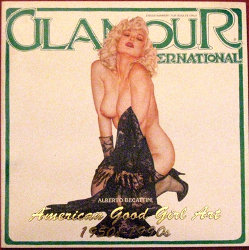 # 19 (1992) - So this issue proves to be the best art presentation of the series, so far. It is the second part of a complete overview of the artists who produced "American Good Girl Art" (the first part being in issue # 17) - this volume collecting examples from the 1950s to the 1990s. 96 pages, and with the front & back covers, 72 primarily featuring the art (half of those each providing a nearly full-page reproduction). Winding through all this is the text of a brief re-introduction and the data on each of the artists, about where their work appeared. Many of the pages where the text dominated the page still have a smaller example, or two, of the sampled art. There are examples from ads, comics and book covers (the latter are frequently poorer reproductions). Many of the images were from cartoons, but the fact that they are stripped of their humorous captions was off-putting. Speaking of captions, each art piece was identified with the artist's name, the creation year and the original publisher. I keep this book put away from children because one or two of the images cross the salacious-pose-line a bit too far to not err on the side of caution. The 'well-presented' artists are: John Bolton, John Byrne, Joe Chiodo, Rich Corben, Olivia DeBerardinis, Howell Dodd, Will Elder, Enrich, José Gonzalez (2), Brad Gorby, Paul Gulacy**, Adam Hughes, Daan Jippes, Gil Kane, Ken Kelly*, Jim Lee, Don Lewis (3), Earl MacPherson (2), Charles Miller, Rowena Morrill, Gray Morrow, Julian Paul, Vic Prezio, Mel Ramos, Steve Rude, Mark Schultz, Doug Sneyd, Erich Sokol, Dave Stevens**, Al Stine (2), Boris Vallejo*, and Al Williamson. # 19 (1992) - So this issue proves to be the best art presentation of the series, so far. It is the second part of a complete overview of the artists who produced "American Good Girl Art" (the first part being in issue # 17) - this volume collecting examples from the 1950s to the 1990s. 96 pages, and with the front & back covers, 72 primarily featuring the art (half of those each providing a nearly full-page reproduction). Winding through all this is the text of a brief re-introduction and the data on each of the artists, about where their work appeared. Many of the pages where the text dominated the page still have a smaller example, or two, of the sampled art. There are examples from ads, comics and book covers (the latter are frequently poorer reproductions). Many of the images were from cartoons, but the fact that they are stripped of their humorous captions was off-putting. Speaking of captions, each art piece was identified with the artist's name, the creation year and the original publisher. I keep this book put away from children because one or two of the images cross the salacious-pose-line a bit too far to not err on the side of caution. The 'well-presented' artists are: John Bolton, John Byrne, Joe Chiodo, Rich Corben, Olivia DeBerardinis, Howell Dodd, Will Elder, Enrich, José Gonzalez (2), Brad Gorby, Paul Gulacy**, Adam Hughes, Daan Jippes, Gil Kane, Ken Kelly*, Jim Lee, Don Lewis (3), Earl MacPherson (2), Charles Miller, Rowena Morrill, Gray Morrow, Julian Paul, Vic Prezio, Mel Ramos, Steve Rude, Mark Schultz, Doug Sneyd, Erich Sokol, Dave Stevens**, Al Stine (2), Boris Vallejo*, and Al Williamson.
* - Note that Vallejo & Kelly's 'well-presented' pieces here can additionally be found so in their own collections on The List.
** - Note that Stevens & Gulacy's 'well-presented' here pieces cannot additionally be found so in their own collections farther down The List.
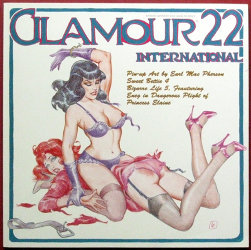 # 22 (1996) [-BELOW THE LINE-] Not appropriate for children or adolescents. This 84-page issue is a strange one. While having *some* art (as this site defines it), it focused on other items, such as a complete reprinting of Earl MacPherson's 30-page instructional volume Pin-Up Art, Eric Stanton's 4-page comic story "Bondage Babes", as well the one by Gene Bilbrew called "Dangerous Plight Of Princess Elaine" (15 pages of Egyptian/Phoenician bondage situations), not to mention more Bettie Page cheesecake & gag-photo-fests from Robert Harrison's magazines. All that left only 31 pages of non-sequential art - 13 multi-image groupings and 18 pages dominated by a single large reproduction. So, the 'well-presented' artists here are: Harmond Balds, Gene Bilbrew (7), Leone Frollo (6), Earl MacPherson (2), Denis Sire (2). The tied-up fetishism on parade leads to keeping this book out of sight of minors. # 22 (1996) [-BELOW THE LINE-] Not appropriate for children or adolescents. This 84-page issue is a strange one. While having *some* art (as this site defines it), it focused on other items, such as a complete reprinting of Earl MacPherson's 30-page instructional volume Pin-Up Art, Eric Stanton's 4-page comic story "Bondage Babes", as well the one by Gene Bilbrew called "Dangerous Plight Of Princess Elaine" (15 pages of Egyptian/Phoenician bondage situations), not to mention more Bettie Page cheesecake & gag-photo-fests from Robert Harrison's magazines. All that left only 31 pages of non-sequential art - 13 multi-image groupings and 18 pages dominated by a single large reproduction. So, the 'well-presented' artists here are: Harmond Balds, Gene Bilbrew (7), Leone Frollo (6), Earl MacPherson (2), Denis Sire (2). The tied-up fetishism on parade leads to keeping this book out of sight of minors.
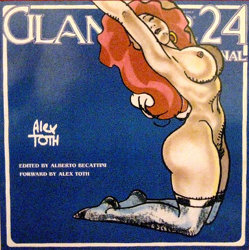 # 24 (1997) [-BELOW THE LINE-] As this issue focused so much on a single artist, Alex Toth, the book also has its own separate, duplicate entry. It just missed getting up on to The List because it isn't much of a collection of his art. It is 96 pages, but only 38 pages could be said to feature single images, rather than text, model sheets or pages of his sequential art. And only 16 of those pages are each dedicated to a single large reproduction. Even counting the impressive pieces on both the front & back covers doesn't get to an adequate total. And a not-insignificant portion of what art there is presented is from other artists in an effort to show his influence on them. The sections are entitled Toth On Women - And More, Alex Toth And The Dark Side Of Comics, Toth's Heroes Portfolio, Toth's Women Portfolio, Toth On Toth, and a Bibliography of the artist, pulling together information on where to find his work and articles about him. There is some nudity, but this is one of the tamest issues of this series. Anyway, in addition to Toth's dozen large reproductions, you will also find one 'well-presented' piece each from Howard Chaykin, Joseph Clement Coll, Mike Mignola, Frank Miller, Jerry Robinson and Paolo Serpieri. # 24 (1997) [-BELOW THE LINE-] As this issue focused so much on a single artist, Alex Toth, the book also has its own separate, duplicate entry. It just missed getting up on to The List because it isn't much of a collection of his art. It is 96 pages, but only 38 pages could be said to feature single images, rather than text, model sheets or pages of his sequential art. And only 16 of those pages are each dedicated to a single large reproduction. Even counting the impressive pieces on both the front & back covers doesn't get to an adequate total. And a not-insignificant portion of what art there is presented is from other artists in an effort to show his influence on them. The sections are entitled Toth On Women - And More, Alex Toth And The Dark Side Of Comics, Toth's Heroes Portfolio, Toth's Women Portfolio, Toth On Toth, and a Bibliography of the artist, pulling together information on where to find his work and articles about him. There is some nudity, but this is one of the tamest issues of this series. Anyway, in addition to Toth's dozen large reproductions, you will also find one 'well-presented' piece each from Howard Chaykin, Joseph Clement Coll, Mike Mignola, Frank Miller, Jerry Robinson and Paolo Serpieri.
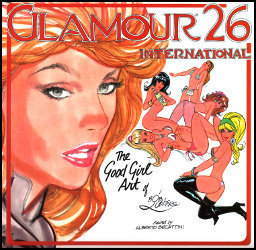 # 26 (2001) As this issue focuses so much on a single artist, Bob Lubbers, I've also given the 12-by-12-inch book its own separate, duplicate stand-alone entry. While so much of Lubbers's career was as a 'ghost-artist' on Al Capp's LI'L ABNER newspaper comic strip (for which he clearly enjoyed being part of the endeavor), he seems most remembered for when he got out from under all that and worked on projects that he could put his own stamp on. His free-&-breezy mainstream style, especially as it applied to attractive women, garnered accolades far and wide. A strong foundation for that was built in the work he did in the 1950s comic-book heyday. This book is his own brief memoir of that long career (it also includes a checklist of his publication-appearances). 98 pages in all (with new paintings he did for the front & back covers), 58 of those pages let his art dominate, 11 in featured large reproductions. A lot of the other pages (non-art as this site counts them) is the exhibit of sequential art, strips & comic pages, that he worked on. There is a bit of playful nudity in his sketches, but this has to be included among the 'tame' issues of the series. Everything is clearly & concisely captioned. (Don't forget that, like most Glamour International publications, the main text appears here in English, French and Italian). # 26 (2001) As this issue focuses so much on a single artist, Bob Lubbers, I've also given the 12-by-12-inch book its own separate, duplicate stand-alone entry. While so much of Lubbers's career was as a 'ghost-artist' on Al Capp's LI'L ABNER newspaper comic strip (for which he clearly enjoyed being part of the endeavor), he seems most remembered for when he got out from under all that and worked on projects that he could put his own stamp on. His free-&-breezy mainstream style, especially as it applied to attractive women, garnered accolades far and wide. A strong foundation for that was built in the work he did in the 1950s comic-book heyday. This book is his own brief memoir of that long career (it also includes a checklist of his publication-appearances). 98 pages in all (with new paintings he did for the front & back covers), 58 of those pages let his art dominate, 11 in featured large reproductions. A lot of the other pages (non-art as this site counts them) is the exhibit of sequential art, strips & comic pages, that he worked on. There is a bit of playful nudity in his sketches, but this has to be included among the 'tame' issues of the series. Everything is clearly & concisely captioned. (Don't forget that, like most Glamour International publications, the main text appears here in English, French and Italian).
Other Glamour International releases
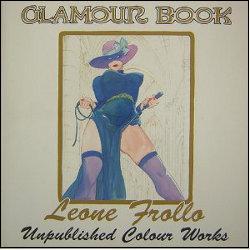 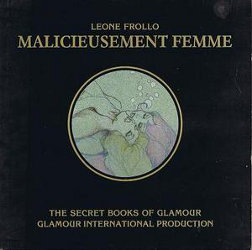 Glamour International's Leone Frollo Collections Glamour International's Leone Frollo Collections
 The Good Girl Art Of Bob Lubbers (Glamour International #26) The Good Girl Art Of Bob Lubbers (Glamour International #26)
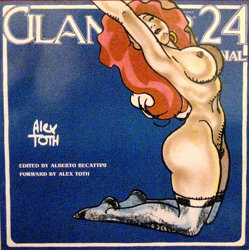 Alex Toth (Glamour International #24) [BELOW THE LINE] Alex Toth (Glamour International #24) [BELOW THE LINE]
SEND US A COMMENT (goes via e-mail - all info kept anonymous, but comment itself may be shared . . .)
|
